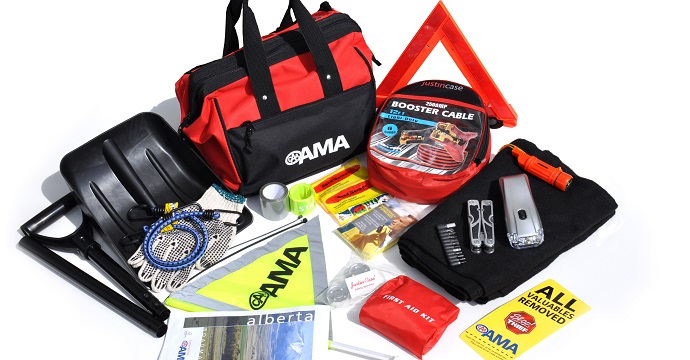With snow and cold weather coming our way, drivers across Alberta need to be prepared for inclement weather. That means making sure your vehicle is stocked with proper supplies and is mechanically sound.

READ MORE: Your car can be affected by the cold just as much as you can
Block heater and engine maintenance
The mercury is set to drop every day this week, with temperatures in the mid minus-twenties dipping close to -30 C overnight on the weekend.
To make sure your oil and coolants stay warm so your vehicle will start easily, the Alberta Motor Association recommends a vehicles’ block heater be plugged in for at least four hours when the outdoor temperature is -15 C or below.
“Pull out that extension cord, start getting ready to plug your vehicle in,” Ryan Lemont, manager of AMA Driver Education, said Tuesday morning when sharing some tips for getting ready for the deep freeze.
Don’t know if your block heater even works? Those who are mechanically-inclined can use a multimeter to test for resistance. Otherwise, Lemont said AMA crews can check it for you.
“They can actually test your block heater for you to make sure that it’s working, because that’s one of the main things that you need — making sure that it’s actually going to work for you.”
READ MORE: What to do when waiting for a tow truck
If your vehicle doesn’t have a block heater, AMA says switching to synthetic oil will help the engine turn over in cold weather.
Drivers are advised to make sure their gas tank is at least half full and consider using gas-line antifreeze. Making sure that your radiator antifreeze is also topped up is important.
“Make sure that you get the recommended antifreeze mixture depending on your vehicle,” Lemont said.
Car battery testing
Last February, AMA said it received a record 31,000 calls over three days, with many related to battery issues. Cold weather causes batteries to weaken and can lead to sluggish starts and difficulty turning over an engine in the winter.
Other signs of a weak battery include dim headlights while idling, frequent boosts/not holding a charge, vehicle slow to turn over and engine cranks but doesn’t start.

A survey conducted by AMA in November found a lack of awareness as the leading factor for Albertans not preparing their vehicles for winter driving.
According to the survey, 38 per cent of Alberta drivers have never had their battery tested, wait “until it fails for the first time” or wait “until after the five-year mark.”
“If your batteries just getting up there in that age, you might want to start thinking about either getting it tested and if needs to be replaced,” Lemont said.
READ MORE: Too many Albertans are not preparing their vehicles for winter: AMA survey
Car batteries can be tested with a multimeter and a reading of about 12.6 volts or higher means your battery has a good charge, according to automotive manual publisher Haynes.
If you have any doubts about your battery’s health, AMA recommends considering alternate transportation until a test is completed or new battery is installed.
Emergency roadside kit
Always carry an emergency kit to help ensure your safety in the event of an unexpected breakdown, AMA reccomends. This should include things like a blanket, warm clothing, caution triangles, a flashlight, gloves, and a folding shovel.
“If for some reason our vehicle breaks down, you don’t want to get stuck out in the cold somewhere,” Lemont said.
(A complete list of items to have in a roadside emergency kit can be found at the bottom of this article.)
Adjusting your driving habits
Beyond maintenance, adjusting your driving habits in the cold and snowy weather is important.
AMA also recommends checking your tire pressure as it gets colder, saying most tires lose one pound per square inch for every 5 C drop in temperature.
Also consider having winter tires, which AMA said provide traction on snow and ice, reduce stopping distance, and provide better control.
“Make sure you give yourself lots of room between yourself and the vehicle in front of you,” Lemont said. According to AMA, 31 per cent of collisions are caused by following too closely.
READ MORE: 5 things to do if you’re in a car crash
AMA recommends you clear off your vehicle thoroughly before leaving to ensure your lines of sight aren’t obstructed by snow or ice.
A snowfall warning was issued west of Edmonton Tuesday morning, with between 10 to 20 centimetres of snow expected by Wednesday, and Environment Canada said a Pacific system would move east across Alberta.
“We’re expecting some snow. Maybe clear your vehicle off, but also turn your headlights on, make yourself visible for people around you as well,” Lemont said, while reiterating the need to watch out for emergency vehicles and tow trucks on the side of the road.
“We had one of our operators hit not too long ago on the side of the road,” he said in reference to a tow truck driver who was hit in south Edmonton on Dec. 13, 2019. The worker suffered injuries to his arm and was taken to hospital.
READ MORE: Myth-busting winter driving wives’ tales

Roadside emergency kit contents recommended by AMA:
- booster cables
- phone charger
- hand/foot warmers
- reflective armbands
- ice scraper
- folding shovel
- sand/kitty litter
- fire extinguisher
- multi-tool (pliers, knife, etc.)
- candles for light and heat
- waterproof matches
- tin can (to hold the candles)
- small first aid kit
- self-powered flashlight
- work gloves
- paper towel/rags
- warm clothing
- jug of water
- protein bars (rotate regularly)
- caution triangle for visibility
- warm blanket
- local map
- duct tape
READ MORE: What to pack in your emergency roadside kit
Roadside emergency kits, which include many of these items and a few more, are also available at any AMA centre.




Comments